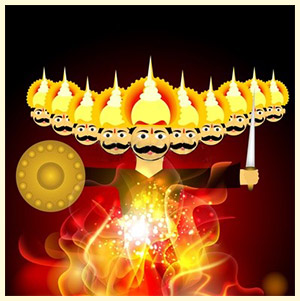Ram Lila
Dussehra is celebrated in diffrent ways in different parts of India. In Dussehra celebrations across North Indian states, Ram Lila is an integral tradition. An age-old custom of the Dussehra festival, Ram Lila celebrates the legend of Lord Ramachandra, the god-incarnate king who is believed to be the reason behind the festival. Know all about this beautiful tradition. If you like our article on Ram Lila, just click here and share it with everyone. Have a grand Dussehra celebration!
About Ramlila, the play enacted at Dasara
According to a popular belief, Dussehra celebrates the victory of Lord Ram over the demon king of Lanka, Ravan. The sacred Indian epic 'Ramayan' mentions the birth of Lord Ram, the seventh incarnation of Lord Vishnu, during "Satyug" (the age of truth) some ten thousand years ago in Ayodha that belongs to the present day state of Uttar Pradesh in India.

The epic mentions how Lord Ram, the god-incarnate, went to serve a period of exile for 14 years under the order of his father - King Dasharatha. Along with his devoted wife Sita and his faithful brother Lakshmana, Ram faced many hardships during this period prominent among which was the abduction of Sita by the ten-headed Ravana. On a similar day as Dussehra in Satyug, Ram (the eighth incarnation of Lord Vishnu), is said to have killed Ravan, who had abducted his wife Sita. With brother Lakshman, follower Hanuman, and an army of monkeys on his side Rama fought a great battle for ten days to rescue his wife. The word "Dussehra" can thus be interpreted as "Dasa-Hara", which stands for the cutting of the ten heads of Ravana by Lord Rama.
Dussehra is celebrated by many people of Northern India to commemorate this victory of Lord Rama over Ravana. All over northern India this scene of execution of Ravan by Lord Ramachandra is enacted in the form of a dramatic folk play, known as "Ram Lila", with actors dressed as Rama and the other characters. The word "Ram Lila" actually means the blissful actions of Rama (which was as if a sport for the god-incarnate).
Predominantly an Indian tradition, the play is held in makeshift open-air stages at night and often performed for over ten or more successive nights, timed to culminate in the festival of Dussehra , that commemorates the victory of Lord Ram. In the Northern states of India, Ram Lila is celebrated with great exuberance. In North India, the grounds where Ram Lilas are held are known as "baaras" and amateur actors get a chance to exhibit their talent to the full. Often a singer (occasionally a priest) recites from the sidelines relevant verses during scene-changes or at moments of dramatic tension. These recitations and the narrative of the play are generally based on Gosvami Tulsidas' version of the Ramayan, in the Awadhi language, but often improvised and changed according to audience reactions. The play is performed to the accompaniment of drumbeats and other music. The atmosphere is usually festal and unrestricted, with members of the audience whistling and commenting as the story proceeds.
The killing of Ravana by Lord Rama is enacted in a beautiful way by local actors, often amateur performers and drawn from the same social grouping as the audience. Huge effigies of the ten-headed Ravana, his brother Kumbhakarna and his son Meghnada are placed in open spaces. A little distance away is constructed an enclosure which represents Lanka(Ceylon), Ravana's kingdom. Here the principal events of the rescue of Sita by Rama, as recorded in the Ramayana, are acted. Little boys dress up to play the parts of the other characters like the monkey soldiers of Ramachandra and of course, Hanuman the monkey-general. After the effigies have been set up, local actors dressed as Lord Rama, his consort Sita and his brother Lakshman arrive. The actor dressed as Lord Rama shoots an arrow of fire at the navel of Ravana which also serves to burn the other effigies, all of which are stuffed with explosive material. As the huge structures burn with deafening blasts, shouts of merriment and triumph arise from the spectators. Thereupon, Lord Rama rescues his consort Sitadevi and carries her off in a chariot with further applause. With the burning of the effigies, the assembled people are asked to burn the evil within them, and thus follow the path of virtue and goodness, bearing in mind the example of Ravan, who was destroyed for his evil ways despite having might and monarchy. Fairs are usually held on this occasion with lots to eat, buy and enjoy.
In rural areas such is the enthusiasm among folk people for Ram Lila that hundreds of them often make long journeys at night to attend the play. Though the play itself is religious in theme, it appeals to people from non-Hindu segments of the community as well. Most of these performance are usually financed by funds raised in the community, often by self-organized Ramlila Committees.
The Ramlila is staged in most countries that have a Hindu population. Apart from the northern and central regions of India, it is also performed in places outside the Indian subcontinent like Nepal, Pakistan, Fiji, Mauritius, South Africa, Guyana, Surinam, Trinidad and Tobago, Great Britain, the United States, and Australia.

 Mother's Day
Mother's Day Passover
Passover Good Morning
Good Morning